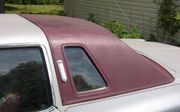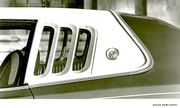| |
Vinyl roof
Car Show
Vinyl roof
Vinyl roof refers to a
vinyl covering for an automobile's top. This covering was originally
designed to give something of the appearance of a convertible to models
with a fixed roof, but eventually it evolved into a styling statement in
its own right. Vinyl roofs were most popular in the American market, and
they are considered one of the period hallmarks of 1970s Detroit cars. Vinyl roofs were also very popular on European- (especially UK-)
and Japanese-built cars during the 1970s, and tended to be applied to
sporting or luxury trim versions of standard saloon (sedan) models by
pretty much the whole gamut of manufacturers.
History
The first use of this technique goes back into the
1920s, when leather and canvas were sometimes used along with landau bars, to
give a fairly accurate reproduction of a horse-drawn carriage's movable top. The
technique fell out of favor in the 1930s and 1940s, when
smoother, "envelope" bodies began to be fashionable; for these designs, the look
of the modern, integrated metal roof was important.
Lincoln used the convertible look on some of its Cosmopolitan coupes in the
1950s, as did the Kaiser firm on its Manhattan sedans, although the material was
still canvas. In the very late 50s, Chrysler's Imperial made a limited use of
true vinyl on some models. Probably the first modern vinyl roof as it would
later be accepted, though, appeared as an option on the 1962 Ford Thunderbird, a car which also re-introduced landau bars as a styling
touch. The vinyl covering proved popular, and some form of vinyl trim would be
commonly be seen on Thunderbird roofs for the next two decades.
Other manufacturers noticed immediately that the new look could be profitable
– it didn't cost very much to add, but many buyers willingly paid a premium for
it. Vinyl appeared on some coupe models in GM's
1962 full-size line. Chrysler took the first step toward moving the look out of
the higher-price class, however, when they made a partial vinyl roof available
on the compact 1963 Dodge Dart. Ford soon offered it on the first Mustang
as well. By mid-decade, four-doors as well as coupes could be topped with a
number of colorful vinyls.
From that point on, vinyl proliferated rapidly and became very common in most
car classes by the late 60s, even appearing on some station wagons. Vinyls were
produced that mimicked other materials such as (ironically) canvas, and even
alligator hide. Chrysler briefly produced some very bizarre " " patterns, with
paisley or floral designs – this was called the "Mod Top" option. The
Mercury Cougar briefly offered a houndstooth pattern. There was even an
aftermarket spray-on product that claimed to add that factory vinyl look, but
mostly it just added the spray-on look. By 1972, even the humble Ford Pinto sported a vinyl roof option, and a Ford sales brochure of the time
conceded that vinyl was mostly for looks, but gamely averred that a small case
could be made for its sound insulating qualities. In a hailstorm, that might
have been true.
At about that same time, the modern opera window first appeared, and it went
so well with a vinyl surround that the two together became emblematic of
American body design in the 1970s. During
this period, vinyl with padding under it was sometimes used, allowing the top to
somewhat mimic the feel as well as the look of a genuine convertible.
European and Japanese manufacturers were not immune to this trend. Chrysler
used it on upmarket models of its Hunter and Avenger saloons; Ford had vinyl
roofs on Escorts, Cortinas, Taunuses and Granadas into the early [1980s]].
British Leyland had vinyl roofs on the last Wolseley and top-end Leyland
Princess models. Toyota adopted vinyl roofs for its Corona sedans in the
mid-1970s, and they could be found on Nissan Laurels and Cedrics.
Vinyl continued to appear in many car lines through the 1980s, but the coming
of the "aero look," first introduced to the US market by the
1983 Thunderbird,
tended to militate against both opera windows and vinyl roofs, as their more
formal style did not go well with the sleek profile designers were beginning to
emphasize. During this final phase, canvas-look tops, often called
cabriolet
roofs, with simulated convertible top bows under the fabric, gained some
popularity. The availability of all vinyl styles dwindled in the
1990s, until the 1998 Cadillac Fleetwood Limited offered one of the very last ones.
Hearse and limousine bodies almost universally still have vinyl tops. Not only are they part of the
expected style of those vehicles, but they have a practical advantage in
covering up the welded body seams that result when standard sedans are stretched
to greater length. Aftermarket customizers also continue to install vinyl roofs
of various types for drivers who want them. These are usually seen on Cadillacs
and Lincolns, but can be fitted to virtually any kind of car.
Styles
Four major styles of vinyl roof evolved during the 1960s and 1970s, with a
couple of odd variants thrown in:
- FULL - this is the most commonly seen style, in which the vinyl
simply covers the whole top of the car, including the rear quarter panels.
The windshield pillars may or may not be covered. If a center sedan pillar
exists, it is usually not covered, but exceptions to this rule were made.
This is the type that was almost always used on four-door models.
- HALO - this type is similar to the above, but the vinyl stops
just short of the tops of the side windows and windshield, allowing a "halo"
of painted sheet metal to appear between the vinyl and the glass area.
 1964 Chrysler 300K - canopy vinyl
1964 Chrysler 300K - canopy vinyl
- CANOPY - in this style, the vinyl covering is applied only to the
front half or two thirds of the roof, usually ending at the trailing edge of
the rear side windows. The windshield pillars are very commonly covered in
this style, but the quarter panels never are.
 1975 Chrysler Cordoba - landau vinyl
1975 Chrysler Cordoba - landau vinyl
- LANDAU - this is almost the opposite of the canopy, as the vinyl
covers the rear quarter or third of the roof, including the quarter panels,
coming as far forward as the trailing edge of either the rear or front side
window. In common parlance, this was often called the "half roof," although
logically that term could apply to the canopy as well.
The above styles were all used by more than one manufacturer. Two others were
unique to one company or nearly so:
 1973 Dodge Charger - "up and over" vinyl
1973 Dodge Charger - "up and over" vinyl
- Chrysler had a design for its large and intermediate coupes in the mid
to late 70s that was often called "up and over." These cars all had
opera windows, and the vinyl extended to only a couple of inches behind the
opera window rather than all the way to the rear window as with a full vinyl
treatment. The line of the vinyl then turned upward to run over the top of
the car, leaving a margin of sheet metal almost like a roll bar sticking up
at the very back of the roof. No one else used this style.
- Ford in the late '70s managed to install both the landau and canopy
styles on one vehicle. On vinyl-equipped '77-'79 Thunderbirds, two separate
vinyl areas existed, one starting at the base of the windshield pillars and
extending back to the trailing edge of the front side windows, and another
starting at the base of the rear window and coming forward as far as the
leading edge of the rear side window. These were separated by a
targa
band of sheet metal in the middle of the roof, which swept down at the sides
to form a thick sedan-like pillar on the sides. The opera window was mounted
in this pillar and was surrounded by sheet metal, not touching either vinyl
area. Three pieces of glass were mounted on each side of these cars; the
Fairmont Futura had a very similar style, differing only in not using the
center opera window. Although it is rare, a comparable two-piece roof was
available on the AMC Pacer.
See also:
Car
body styles
Issues for Collectors
Many 60s and 80s cars will have vinyl, and most 70's ones. Unfortunately,
vinyl surfaces are not as durable as sheet metal and are particularly prone to
sun damage, so faded, cracked, or actually ragged tops are commonly seen. Even
where this is not the case, the trim around the tops often trapped water and
caused rust, and this could percolate under the vinyl itself, where rusting even
to the point of sheet metal perforation could rapidly occur. The only real
exceptions would likely be cars from a dry climate which were well maintained
and kept garaged. Replacement of a vinyl top can be costly, even leaving aside
repair of any rust damage. For unusual vinyl grains and patterns, an exact
replacement could be impossible to find.
External links
Fast vinyl
Formal vinyl
Final vinyl
Odd vinyl
Confusing vinyl
Practical vinyl
Contemporary vinyl
Home | Up | Hidden headlights | Personal luxury car | Streetfighter | Tailfin | Vinyl roof | Whitewall tire
Car Show, made by MultiMedia | Free content and software
This guide is licensed under the GNU
Free Documentation License. It uses material from the Wikipedia.
|
|







